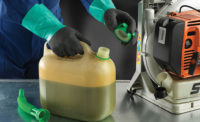QUESTION:
Workers sometimes complain that they don't wear gloves because of bad fit or poor grip. What can I do to motivate workers to wear gloves?
ANSWERS:
First, have them try different size gloves or reference a glove-sizing chart to properly measure their hands.Second, have them try different types of gloves. Today, medical and industrial grade thin-wall disposable gloves are available in a variety of synthetic materials with excellent barrier protection and good chemical resistance.
Finally, remind them of the benefits of wearing hand protection, such as avoiding bacteria, abrasions, and chemical burns.
Terrance McAbee, Product Associate, Sempermed USA
Comfort and manual dexterity are key issues. For example, in high-heat, injection molding work, the ability to digitally manipulate a product is critical. A glove that is too bulky will fall short. And if a worker chooses a glove that was never intended for such situations, the result will be equally disastrous.
Style and personal preference are other factors. These issues have less to do with safety than correct fit, tactile sensitivity and manual dexterity, but you must understand the role style plays in glove usage.
Michael Gompers, General Purpose & Cut-Resistant Product Development Manager, Best Manufacturing Co.
Give employees options. Mechanics gloves offer an excellent fit, good general hand protection and style, but aren’t as cost-effective as flat dipped rubber, nitrile, or air-injected nitrile safety gloves. These offer a great fit, breathability, tactile dexterity, and reduced hand fatigue.
A sure hit for the employees will be the newest breed of gloves — a hybrid cross between the mechanics and the flat dipped gloves that offers a snug fit, comfort, and a superior grip.
David Gellerman, Marketing Director, Global Glove & Safety Manufacturing
After years and sometimes only months of chemical exposure, it’s quite common for the skin to become hard, brittle and even crack, producing aggravating, infectious sores that take months to years to heal correctly. No matter how tough you think you are, your hands aren’t any tougher than anyone else’s hands. Gloves provide the necessary protection that you need.
Tonya Walker, Marketing Director, SAS Safety Corp.
Involve workers in the decision-making process. Too often workers are just given low-cost, low-quality gloves. New materials and glove designs now provide breathability, fit, dexterity and fashion, while new palm technologies offer grip and abrasion resistance tailored to specific tasks.
Eric Jaeger, Director, Research and Development, Ironclad Performance Wear
Educate to assure awareness of new hand protection styles available. New technology and new forms of hand protection manufacturing have created better fitting and more functional glove styles, providing better sense of touch and tack ability.
Educate workers of their risks of injury from not wearing hand protection. Hand injuries consistently rank as the second most common injury reported by the National Safety Council.
Larry Garner, Vice President, MCR Safety
Proper glove fit (see glove size chart) is essential for ease of movement and reduction of hand fatigue, but protection, ergonomics and comfort must also be taken into account. Also, identify hand hazards, evaluate the wide range of grips, cuffs and materials available, and ensure the right glove is used for each job.
Carmen Castro, Marketing Manager, MAPA Professional
Not wearing thin-film gloves — the first barrier of defense against skin (hand) contact with many hazards — due to poor fit is not an acceptable excuse. High-quality latex and non-latex gloves effectively conform to the hand, have reduced modulus (softness) values that make the gloves very comfortable, and have specific surface texture patterns and specialized surface treatments for wet and dry gripping capabilities. The key: select high-quality gloves from a knowledgeable, high-quality glove supplier.
Tito Aldape, Vice President of Regulatory and Scientific Affairs, Microflex Corporation
First, your employee needs to know what hazard or harm might happen. Second, any protective glove, if it is going to be worn, needs to be appropriate for the task and fit well. Work with your employees to identify the threats involved and what parts of the hand are at risk for each application.
Matt Keenan, Safety Apparel Specialist, TurtleSkin by Warwick Mills

